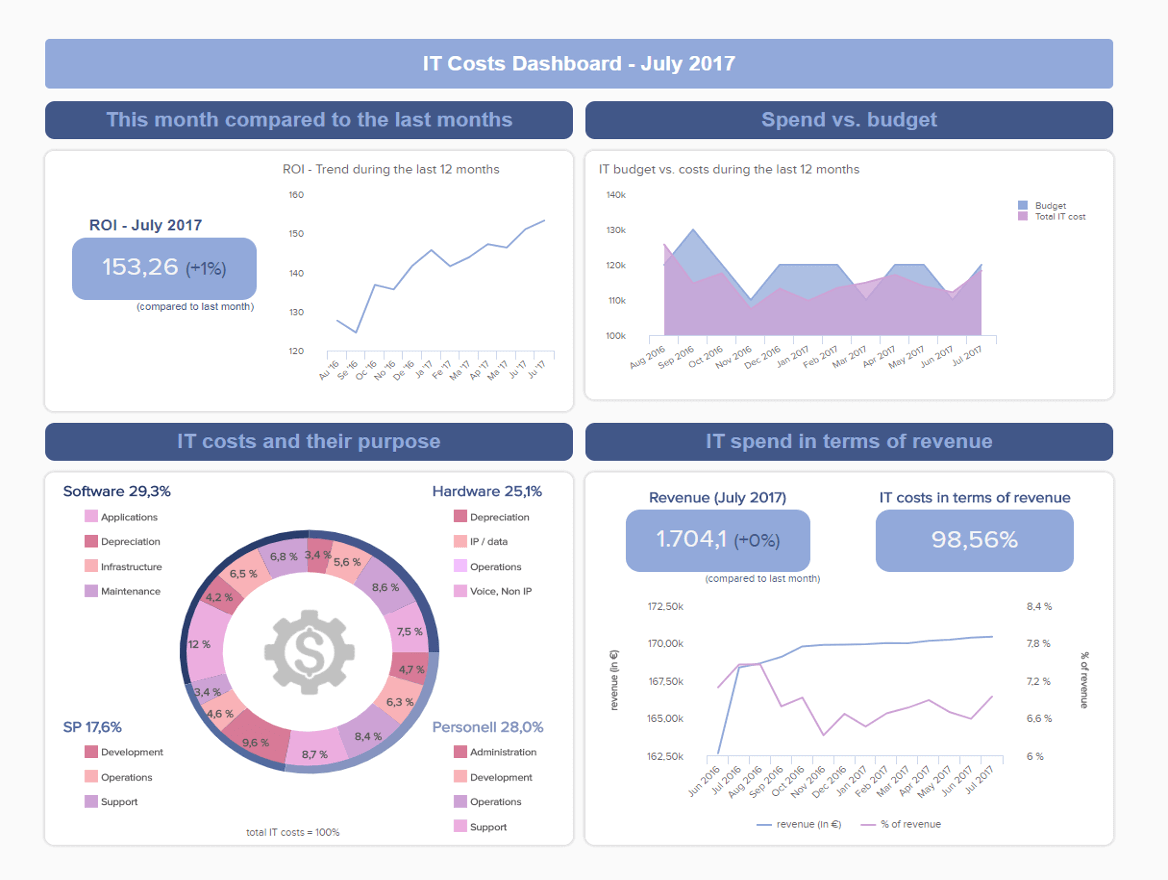Measuring The Efficiency of Your Investments Thanks To IT ROI

Before any project launch, many aspects of said project are analyzed and evaluated: the purpose, the timeline, the tasks, the resources needed, and of course, the budget required. In order to get the budget approval, managers need to convince the financial department that their investment won’t be in vain: they realize an IT ROI calculation - a measure of the return on the investment in the project.
In today’s reality, for most companies the investments are heading towards technology and IT projects. This is why it is critical to understand the value of a technology investment thanks to the ROI calculation. In this article, we will look at what is the return on investment, how to calculate ROI for IT projects, the common mistakes you should be wary of and finally how to communicate it efficiently.
What Is The IT Return On Investment
Strictly speaking, the Return on Investment is the ratio between the net profit of an investment and what it cost to implement it. It is often expressed as a percentage, to represent how much profit was made comparably to the costs.
It is also an efficiency measure, that tells investors how effectively is used every dollar they invest. It is a measure of performance. As Investopedia explains, the ROI varies depending on what you consider to be beneficial returns: tracking the ROI of a marketing campaigns won’t be the same as tracking the ROI of a new manufacturing asset.
IT projects are usually risky, in the way that they often fail to deliver the initial business objectives. Once all the costs related to maintenance, operations, upgrades, migrations etc are paid for, very few is left for innovation. This is why it is all the more important to have a high-quality project management - and this is also why managers should pay a closer attention to their IT ROI.
Why You Need To Measure The IT ROI
You need ROI in the first place to know whether it is worth investing time and money in this new project or technology; and afterwards to double-check if the investment was worth it and meeting your expectations. By looking at past investment choices and performing an ROI analysis, you can assess these decisions and make better costs projections in the future.
You want to know if you are wasting resources on technology that isn’t doing much for you: for instance, someone spending three time as much time on troubleshooting an automated email software than on actually producing content to be sent out. In that case scenario, technology is absorbing staff time and money, and does not give enough back.
Calculating the ROI of your IT project will also help you defend the budget which is allocated, and potentially its extension: by showing your managers you know what you are doing, where you are spending and how well you spend, you demonstrate solid understanding of your department and justify its necessity. It’s a good selling technique for senior executives, as a way to show your contribution to the general mission. It also helps in investment prioritization, by allowing for a project-to-project comparison between investment options. Finally, it also enforces accountability among project executives for the success or failure of the project.
You should also keep in mind, and especially for IT projects, that it can be very hard to express the benefits in numbers - the returns can still be significant albeit in a non-financial form: competitive advantage, increase in customer satisfaction, improved communication in and out, product differentiation, improved customer service and support, etc. A typical example is a business intelligence project: the fallout from BI is often hard to quantify because so widespread and long-term payback. However, there are some ways to calculate the business intelligence ROI.
Experience our 14-days free trial & start maximizing your IT ROI today!
How To Calculate The ROI For IT Projects
IT ROI offers tremendous leverage in establishing the business case to justify technology initiatives. However, you cannot evaluate truly any investment’s profitability if you do not first understand how to calculate the ROI. Let’s go over the ways to do so.
Before anything, you should ask yourself a few questions:
- Can I measure the expected profit/savings?
- Is such profit achievable?
- Will the benefits of this IT project implementation be visible in more than one area of the business?
For the last point, make sure not to count the benefits twice, which would inflate the ROI and skew the results.
So, to calculate the IT return on investment, you first need to identify the costs and benefits and how much you expect them to be; assess the likelihood of them occurring and determine how much you can deviate from expected costs and benefits without losing money.
Step 1 - The costs
At this stage, you should outline all the costs related to the implementation of a new technology - let’s say a software. From the licensing to the implementation, the annual support and the in-house recurring operation costs: all of these categories have specific expense items (software installation, staff training, adaptation of interfaces, etc) that need to be detailed and estimated.
Step 2 - The benefits
The benefits, or profit, that the IT investment will generate is harder to evaluate. We want these benefits to be tangible and monetary, however, as stated earlier, they very well can be non-financial. What should be done in such case is to create an overview of every function that will be positively (or not) affected by the investment and how. In general, though, the benefits of implementing a new technology/software result in improved processes and the automation of manual tasks.
Step 3 - The comparison
Final step of the IT ROI calculation, is to compare the costs to benefits (or savings) to determine the cashflow of the ROI. Hopefully this will return with a good result for your planned IT investment. For an even better assessment, you can evaluate all of it for the best and the worst cases: you will enhance the awareness of the risks of investment.
Common Mistakes To Stay Away From
As for any other project, managers can easily fall in a trap when trying to figure out the ROI for IT projects. One of them that is rather recurrent is to overestimate the benefits expected - in other words, this is the best way to not improve your ROI. On the contrary, sometimes businesses underestimate the initial costs, which leads to an inaccurate calculation.
Another common mistake in ROI calculation, as Joe Knight explains in the Harvard Business Review, is to compare the initial investment to the returns; in the way that initial investments are always in cash, while returns are measured in profits or sometimes revenue. As specified in the last step of our calculation above, the correct approach is to use cashflow.
When it comes to time, it happens that managers forget the value of their time and of their employees’. When the project overruns the deadline, because not enough resources were allocated, it costs more money. However, at this point, you should carefully consider all that is at stake and what is more important: deadline/time, or money/resources. Because implementing more resources to finish the project on time or before due date will very likely overrun the budget much more than exceeding the deadline.
Communicating Your IT ROI Calculations Effectively
To make the most out of your IT ROI estimation and convince your top management or the investors that you have the right calculation backed with real data and communicate it all efficiently, an IT analytics software is the best tool you can use. Indeed, not only will it help you monitor your project in the long run, but it will also enable you to create professional IT dashboards displaying all your information at once - an efficient overview busy executives desperately need.
By forecasting the benefits or simply taking the example of a previous project, you help everyone in the room understand all that is at stake and visualize complex calculations. They have everything in hand to make better data-driven decisions. Hereafter is an example of an IT cost dashboard, focusing on the cost management over one year and showing the evolution of the IT ROI during that time-period.
Experience our 14-days free trial & start maximizing your IT ROI today!
Understanding how to calculate ROI for a project is the first step without which you cannot get a clear vision of the project's goals and benefits, and thus nor your budget approved. Evaluating the IT ROI will help you sell and manage your project better from a financial perspective.
Project managers should fully understand all the elements behind an ROI calculation so as to get the accurate view of the means and resources required, as well as all the benefits the business will gain out of it.
Knowing how to present it to top management and investors is a key action you should not fail - and the use of professional IT dashboards will greatly help you communicate your insights and provide a solid background for the financial evaluation. To benefit from all that a data visualization software can bring, have a go at our 14-day free trial.
